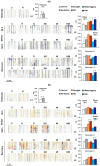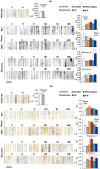Divergent Cross-Adaptation of Herbicide-Treated Wheat and Triticale Affected by Drought or Waterlogging
- PMID: 37569877
- PMCID: PMC10419764
- DOI: 10.3390/ijms241512503
Divergent Cross-Adaptation of Herbicide-Treated Wheat and Triticale Affected by Drought or Waterlogging
Abstract
Widely used agrochemicals that do not exert negative effects on crops and selectively target weeds could influence plant resilience under unfavorable conditions. The cross-adaptation of wheat (Triticum aestivum L.) and triticale (×Triticosecale Wittm.) exposed to two environmental abiotic stressors (drought and waterlogging) was evaluated after treatment with a selective herbicide (Serrate®, Syngenta). The ambivalent effects of the herbicide on the two studied crops were particularly distinct in waterlogged plants, showing a significant reduction in wheat growth and better performance of triticale individuals exposed to the same combined treatment. Histochemical staining for the detection of reactive oxygen species (ROS) confirmed that the herbicide treatment increased the accumulation of superoxide anion in the flooded wheat plants, and this effect persisted in the younger leaves of the recovered individuals. Comparative transcript profiling of ROS scavenging enzymes (superoxide dismutase, peroxidase, glutathione reductase, and catalase) in stressed and recovered plants revealed crop-specific variations resulting from the unfavorable water regimes in combination with the herbicide treatment. Short-term dehydration was relatively well tolerated by the hybrid crop triticale and this aligned with the considerable upregulation of genes for L-Proline biosynthesis. Its drought resilience was diminished by herbicide application, as evidenced by increased ROS accumulation after prolonged water deprivation.
Keywords: ROS; Serrate®; antioxidant enzymes; cereal crops; cross-adaptation; water stress.
Conflict of interest statement
The authors declare no conflict of interest.
Figures







References
-
- Karkanis A., Ntatsi G., Alemardan A., Petropoulos S., Bilalis D. Interference of weeds in vegetable crop cultivation, in the changing climate of Southern Europe with emphasis on drought and elevated temperatures: A review. J. Agric. Sci. 2018;156:1175–1185. doi: 10.1017/S0021859619000108. - DOI
-
- Bradshaw J.E. Plant breeding: Past, present and future. Euphytica. 2017;213:60. doi: 10.1007/s10681-016-1815-y. - DOI
-
- Crossa J., Fritsche-Neto R., Montesinos-Lopez O.A., Costa-Neto G., Dreisigacker S., Montesinos-Lopez A., Bentley A.R. The modern plant breeding triangle: Optimizing the use of genomics, phenomics, and enviromics data. Front. Plant Sci. 2021;12:651480. doi: 10.3389/fpls.2021.651480. - DOI - PMC - PubMed
-
- Erenstein O., Jaleta M., Mottaleb K.A., Sonder K., Donovan J., Braun H.J. Global trends in wheat production, consumption and trade. In: Reynolds M.P., Braun H.J., editors. Wheat Improvement. Springer; Cham, Switzerland: 2022. pp. 47–66.
-
- Blum A. The abiotic stress response and adaptation of triticale—A review. Cereal Res. Commun. 2014;42:359–375. doi: 10.1556/CRC.42.2014.3.1. - DOI
MeSH terms
Substances
Grants and funding
LinkOut - more resources
Full Text Sources

